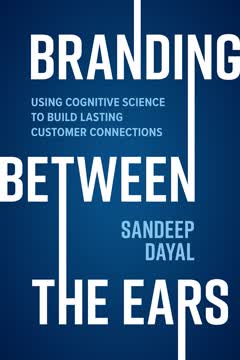つの重要なポイント
1. 認知ブランドは脳の働きに基づき、無意識の意思決定に影響を与える
認知ブランドは、私たちの心に蓄積された経験や幻想の感覚を解き放ち、私たちを幸せにし、ブランドに引き寄せる鍵である。
脳とブランドの整合性。 認知ブランディングは、神経科学と心理学の最新の進歩を活用して、ブランド体験を人間の脳が実際に情報を処理し、意思決定を行う方法に合わせて設計する。このアプローチは、消費者の選択の最大95%が無意識に行われ、純粋に合理的な熟考ではなく、精神的なショートカットや感情的な関連付けによって駆動されることを認識している。
主要な脳のプロセス。 認知ブランディングのフレームワークは、脳の4つの主要な機能サブユニットに焦点を当てている:
- アソシエーター:過去の経験を活用して迅速で直感的な判断を行う
- デリベレーター:必要に応じてより努力を要する分析的な思考を行う
- ラーナー:ブランドに関連する記憶や関連付けを継続的にエンコードし更新する
- コナター:予想される幸福や個人的な目標に基づいて動機付けと行動を駆動する
これらの自然な認知プロセスとブランド戦略を整合させることで、マーケターは消費者に対して意識的および無意識的なレベルで深く共鳴する、より魅力的で記憶に残るブランド体験を創出できる。
2. ブランドの雰囲気は消費者との感情的なつながりと共有価値を生み出す
ブランドの雰囲気は幻想ではなく、契約である。顧客との信頼を裏切るブランドは、抜け出せない深い穴に陥る可能性がある。
感情的な共鳴。 ブランドの雰囲気は、消費者との初期の感情的なつながりを形成し、より深いエンゲージメントの舞台を整える。これらの雰囲気は主に2つの方法で作り出される:
- 共有された感情:消費者の経験に対する共感と理解を示す
- 共有された価値観:ターゲットオーディエンスにとって重要な原因や原則とブランドを一致させる
信頼構築。 効果的なブランドの雰囲気は、以下の方法で信頼を築く:
- 消費者の痛点や願望を認識する
- 共有された価値観に対する真摯なコミットメントを示す
- 親近感や帰属意識を創出する
強力なブランドの雰囲気の例:
- スバルのLGBTQ+コミュニティへの微妙なメッセージ
- ベン&ジェリーズの社会正義へのコミットメント
- ナイキのコリン・キャパニックとのパートナーシップ
これらの感情的なつながりを確立することで、ブランドは消費者がブランドの核心的な価値提案やメッセージに対してより受け入れやすくなるように準備する。
3. システム1イーザーはブランドの選択を直感的で簡単に感じさせる
システム1イーザーは、消費者がブランドの提案を直感的に理解し、抵抗せずに流れに乗るように導くことに関するものである。
認知的な容易さ。 システム1イーザーは、脳が迅速で低労力の意思決定を好む傾向を利用する。これにより、ブランドの選択が以下のように感じられる:
- 親しみやすい
- 真実で本物
- 良い
- 簡単
主要な認知バイアス。 マーケターは、システム1イーザーを作成するためにいくつかの認知バイアスを活用できる:
- アンカリングバイアス:比較のための基準点を提供する
- 損失回避:利益よりも損失を強調する
- 内集団バイアス:帰属意識やアイデンティティを創出する
- 選択支持バイアス:過去の選択のポジティブな面を強調する
効果的なシステム1イーザーの例:
- ディジョルノの「デリバリーではなく、ディジョルノ」キャンペーン
- RxBarの透明な成分リスト
- ステープルズの「イージーボタン」コンセプト
これらの自然な精神的ショートカットと整合させることで、ブランドは消費者にとって直感的で低労力の選択肢となる。
4. システム2デリベレーターは複雑なブランドの意思決定に対して意識的な推論を引き出す
システム2デリベレーターには他の特性がある。精神的な努力を要するため、必要な場合にのみ作動する。
意識的な評価。 システム2デリベレーターは、消費者がより複雑または高リスクのブランドの意思決定を行う必要がある場合に作動する。これにより、以下のように機能する:
- 知覚される価値を増幅する
- 知覚されるリスクを低減する
- 信頼できる理由を提供する
- 意思決定の文脈を再構築する
認知行動療法のインスピレーション。 著者は、システム2デリベレーターと認知行動療法で使用される思考パターンを変える技術との間に類似点を見出している:
- ノーブレイナーメソッド:価値提案を圧倒的に魅力的にする
- 快楽予測:潜在的なポジティブな結果を鮮明に描写する
- 戦うか逃げるか:恐れや懸念に正面から対処する
- フラーティングトレーニング:低コミットメントの試用体験を提供する
効果的なシステム2デリベレーターの例:
- ウーバーの初期の価値提案である利便性とコスト削減
- ワービーパーカーの自宅試着プログラム
- パテック・フィリップの時計を家族の遺産として再構築する
システム2プロセスを活用することで、ブランドは初期の躊躇を克服し、特に高関与の購入に対してより持続的な忠誠心を築くことができる。
5. ブランドの決意は消費者の幸福追求と一致することで行動を促す
消費者のこの探求に役立つ方法を見つけたブランドは、消費者により長く愛される。
幸福の推進力。 ブランドの決意は、幸福の普遍的な追求に基づいており、以下の3つの核心的な内発的動機に対応する:
- 自律性の必要性:自分の選択と運命をコントロールしていると感じること
- 有能感の必要性:スキルを習得し、有能であると感じること
- 関連性の必要性:他者とつながり、何か大きなものの一部であると感じること
コナティブエネルギー。 消費者はこれらのニーズを追求する傾向が異なり、それがブランドの好みや行動に影響を与える。マーケターは、傾向に基づく消費者セグメンテーションを使用して、最も魅力的な幸福提案で適切なオーディエンスをターゲットにすることができる。
効果的なブランドの決意戦略の例:
- ナショナルカーレンタルの「プロのように行動する」キャンペーン(自律性)
- マスターカードの「プライスレス」キャンペーン(関連性)
- ペディアシュアの「子供たちが最大限に成長することを可能にする」ポジショニング(有能感)
ブランドを特定の幸福の形を解き放つ鍵として位置づけることで、マーケターは消費者が製品やサービスを選び続けるための強い決意を生み出すことができる。
6. 効果的なブランド実行は脳が経験を処理し記憶する方法を考慮する
ブランドの印象は、全体のブランド体験のうち、クライマックスとエンドの部分に基づいている。
選択的記憶。 脳はブランド体験のすべての側面を均等に処理したり記憶したりするわけではない。効果的な実行のための主要な原則には以下が含まれる:
- ピークエンドルール:記憶に残るハイポイントと強い結論を作り出す
- 新奇性バイアス:予期しない要素はより注目され、記憶されやすい
- ストーリーベースのリコール:物語は事実や利益のリストよりも記憶されやすい
- マルチセンサリーエンゲージメント:複数の感覚を関与させることで、より強力で全体的な記憶を作り出す
実行戦略:
- 感覚的なタッチポイント(視覚、聴覚、嗅覚など)全体で独自の「ブランドシグネチャー」を作成する
- ブランドの利益をより記憶に残りやすく、関連性のあるものにするためにストーリーテリングを使用する
- 予期しないポジティブな体験で顧客を驚かせ、喜ばせる
- ブランドインタラクションのクライマックスと結論が特にポジティブであることを確認する
効果的な感覚ブランディングの例:
- シンガポール航空のフライト体験全体で使用されるカスタムフレグランス
- バーバリーの特徴的な視覚パターンと店内の香り
- ジョン・ウェストの予期しないユーモラスな「熊との戦い」コマーシャル
ブランド実行を脳が自然に情報を処理し記憶する方法と整合させることで、マーケターはより影響力があり、持続的なブランド印象を作り出すことができる。
7. 倫理的な認知ブランディングは消費者の自律性と社会的な幸福を尊重する
できるからといって、すべきか?
倫理的考慮。 大きな力には大きな責任が伴う。認知ブランディング技術がより洗練されるにつれて、マーケターはその戦略の倫理的な影響を考慮する必要がある。主要な倫理テストには以下が含まれる:
- 規範的命令:これが自分に対して行われることを望むか?
- カテゴリカル命令:全員がこれを行うことが良いか?
- サンシャイン命令:この戦略が公にされることに対して快適か?
潜在的な落とし穴:
- ユーザーインターフェースにおける操作的なダークパターン
- 過剰消費を促進するための認知バイアスの悪用
- 潜在的な利益をサブリミナルな手がかりで誤って伝える
責任ある実践:
- マーケティングの主張や価格設定における透明性
- 本物の社会的利益と一致するブランド目的
- 消費者のプライバシーとデータの自律性を尊重する
- 情報に基づいた意思決定を支援する
倫理的原則を遵守することで、認知ブランディングはブランドと消費者の両方に利益をもたらし、社会に対してもポジティブな貢献をするウィンウィンの結果を生み出すことができる。
最終更新日:
FAQ
What's Branding Between the Ears about?
- Cognitive Science Application: The book delves into how cognitive science principles can be applied to branding, focusing on psychological triggers that make brands resonate with consumers.
- Cognitive Branding Model: It introduces "cognitive brands," which are designed to align with the brain's natural processes, emphasizing elements like good vibes, sense, and resolve.
- Practical Insights: The author provides actionable frameworks and real-world examples for marketers to create brands that connect deeply with consumers.
Why should I read Branding Between the Ears?
- Transformative Perspective: The book offers a fresh take on branding by integrating neuroscience and psychology, moving beyond traditional methods.
- Actionable Strategies: Readers gain practical tools and frameworks that can be immediately applied to enhance branding efforts.
- Credible Resource: Endorsed by industry leaders, it serves as a reliable guide for marketers aiming to innovate and connect with consumers.
What are the key takeaways of Branding Between the Ears?
- Cognitive Brands: Successful brands align with how the brain processes information, focusing on emotional and psychological connections.
- Three Elements: The book highlights brand vibes (empathy), brand sense (making sense of choices), and brand resolve (motivating purchases) as key components.
- Behavioral Insights: Understanding consumer behavior through cognitive biases is crucial for effective branding strategies.
What is the concept of "cognitive branding" in Branding Between the Ears?
- Definition: Cognitive branding involves designing brands that resonate with the brain's natural processes, making them more appealing and memorable.
- Three Components: It includes brand vibes (emotional connection), brand sense (intuitive understanding), and brand resolve (motivation to purchase).
- Practical Framework: The book provides a framework for marketers to create cognitive brands by leveraging consumer psychology.
How does Branding Between the Ears define "brand vibes"?
- Emotional Connection: Brand vibes are the emotional bonds that brands create with consumers, making them feel understood and valued.
- Empathy and Trust: Establishing good vibes involves showing empathy towards consumer experiences and aligning with their values, fostering trust.
- Foundation for Value Proposition: Good brand vibes set the stage for consumers to accept and embrace the main brand message more readily.
What are "System 1 Easers" and how do they work in branding according to Branding Between the Ears?
- Definition: System 1 Easers are elements that help consumers make intuitive and instinctive choices about brands without deep deliberation.
- Cognitive Ease: They create a sense of familiarity, truth, goodness, or ease, making the brand choice feel effortless and natural.
- Examples: Techniques like anchoring bias and loss aversion bias are used to align brand messages with consumers' existing beliefs and preferences.
How does Branding Between the Ears suggest using "System 2 Deliberators" in branding?
- Analytical Thinking: System 2 Deliberators engage consumers in logical reasoning, helping them evaluate the brand's value proposition critically.
- Four Strategies: The book outlines strategies like amplifying value, lowering risk, providing reasons to believe, and framing the brand choice favorably.
- Consumer Empowerment: These strategies help consumers feel more confident in their decisions, leading to stronger brand loyalty.
What role does emotional branding play in Branding Between the Ears?
- Emotional Resonance: Emotional branding is crucial for creating connections that resonate with consumers on a deeper level, influencing their perceptions and choices.
- Risk of Overemphasis: The book warns that overly emotional branding can overshadow the brand itself, leading to poor recall of the brand name.
- Balanced Approach: Successful branding should balance emotional appeal with clear brand messaging to ensure consumers remember both the feelings and the brand.
How can brands create a sense of "resolve" according to Branding Between the Ears?
- Motivation to Act: Brand resolve is about encouraging consumers to take action and make a purchase by linking the brand to their happiness and goals.
- Personal Connection: Brands should resonate with consumers' aspirations and values, making them feel that purchasing the brand will enhance their lives.
- Overcoming Indecision: By addressing consumer hesitations and providing compelling reasons to buy, brands can effectively motivate consumers to choose their products.
How does Branding Between the Ears define happiness in the context of branding?
- Happiness as a Goal: The author states that "all consumers pursue happiness as a conscious or subconscious goal," central to their decision-making.
- Neurochemical Basis: Happiness is linked to the release of specific brain chemicals (dopamine, oxytocin, serotonin, and endorphins) that brands can trigger through positive experiences.
- Anticipatory vs. Consummatory Pleasures: The book differentiates between anticipatory pleasures (imagining future happiness) and consummatory pleasures (experiencing happiness), both of which brands can leverage.
What are some examples of successful brands mentioned in Branding Between the Ears?
- PediaSure: Successfully repositioned from a hospital product to a household brand by addressing parents' concerns about children's nutrition.
- Mastercard: The "Priceless" campaign effectively connected emotional experiences with its brand, enhancing consumer loyalty.
- National Car Rental: The "Go Like a Pro" campaign targeted frequent business travelers by appealing to their need for autonomy and control.
What ethical considerations does Branding Between the Ears address?
- Manipulation vs. Influence: The author warns against using cognitive branding techniques to manipulate consumers in ways that could harm their well-being or financial stability.
- Three Ethical Tests: Introduces the Canonical Imperative, Categorical Imperative, and Sunshine Imperative to help marketers evaluate their strategies.
- Responsibility in Marketing: Marketers are encouraged to use their knowledge of cognitive science responsibly, ensuring that their branding efforts benefit consumers rather than exploit them.
レビュー
本書『Branding Between the Ears』は、主に肯定的な評価を受けており、読者はその認知科学とマーケティング戦略に関する洞察を称賛している。多くの人々は、ブランドが脳科学を活用して持続的な顧客関係を築く方法を理解するのに役立つと感じている。本書は、その明確な構成、最新の事例、そして実践的なアドバイスで高く評価されている。著者のユーモアや複雑な概念を分かりやすく説明する点を評価する読者もいる。しかし、一部のレビュアーは、本書が集中して読む必要があり、製薬業界の例が多いと指摘している。
Similar Books













